Citroen JUMPY RHD 2016 2.G User Guide
Manufacturer: CITROEN, Model Year: 2016, Model line: JUMPY RHD, Model: Citroen JUMPY RHD 2016 2.GPages: 520, PDF Size: 10.54 MB
Page 11 of 520

9
Interior fittings 119 -122
- c up/can holder
-
m
ats
-
s
un visors
-
g
love box
-
s
torage box
-
u
pper storage box
-
accessory socket, USB port, JACK auxiliary socket
Child seats 1 74-181, 184-185
ISOFIX mountings 1 86 -187, 190 -192
Rear side windows
1
24, 195
Fixed one-piece bench seat
1
10 -112
Rear seat and fixed bench seat
1
13 -115
Seat labels
1
16
2-seat front bench seat
1
04-105
Heated bench seat
1
05
Rear heating - air conditioning
1
37
Temporary puncture repair kit
2
87-289, 290 -295
Spare wheel, jack, changing a wheel, tools
2
87-289, 296 -302
Seating area fittings
1
23 -124
-
h
igh load retaining net
-
r
ear windows
Accessories
2
71-272
Rear courtesy lamp
1
42
Changing courtesy lamp bulbs
3
12 Rear view mirror
1
45
Front courtesy lamp
1
42
Changing courtesy lamp bulbs
3
12
Front, side airbags
1
70 -173
Deactivating the passenger front airbag
1
72, 177
12 V accessory sockets
1
21
USB port
1
22
JACK auxiliary socket
1
22
Front seats, adjustments, head
restraint
9
9-103
-
m
anual adjustments
-
e
lectric adjustments
-
t
able positon
-
h
ead restraints
-
hea
ted seats
Seat belts
1
66 -168
Fixed one-piece bench seat
1
10 -112
Rear seat and fixed bench seat
1
13 -115
Seat labels
1
16
Interior
Tool box 2
87-289
.
Over view
Page 12 of 520
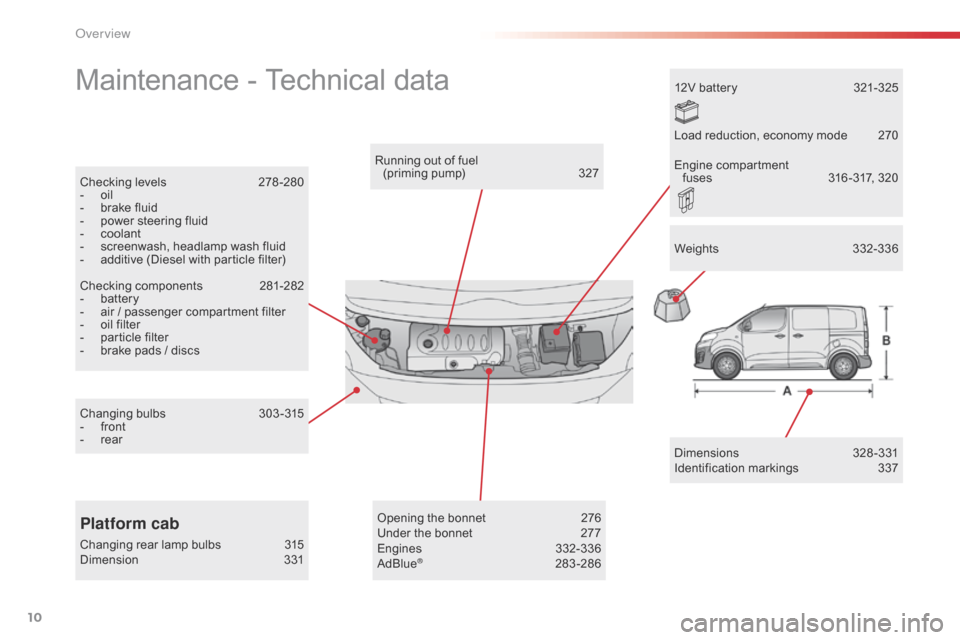
10
Maintenance - Technical data
Dimensions 328-331
Identification markings 3 37
Running out of fuel
(priming pump)
3
27
Checking levels
2
78 -280
-
o
il
-
b
rake fluid
-
p
ower steering fluid
-
c
oolant
-
s
creenwash, headlamp wash fluid
-
a
dditive (Diesel with particle filter)
Checking components
2
81-282
-
b
attery
-
a
ir / passenger compartment filter
-
o
il filter
-
p
article filter
-
b
rake pads / discs
Changing bulbs
3
03-315
-
f
ront
-
r
ear
Platform cab
Changing rear lamp bulbs 3
15
Dimension 3 31 12V battery
3
21-325
Opening the bonnet
2
76
Under the bonnet 2 77
Engines 3 32-336
AdBlue® 28 3-286Weights
33
2-336
Load reduction, economy mode
2
70
Engine compartment
fuses
3
16 -317, 320
Over view
Page 13 of 520

11
92109
177
11 6 194 186
140 323 276
11 6
107
107
Labels
.
Over view
Page 14 of 520

12
Eco-driving is a range of everyday practices
that allow the motorist to optimise their fuel
consumption and CO
2 emissions.
Eco-driving
Optimise the use of your
gearbox
With a manual gearbox, move off gently and
change up without waiting. During acceleration
change up early.
With an automatic or electronic gearbox,
give preference to automatic mode and avoid
pressing the accelerator pedal heavily or
suddenly.
The gear efficiency indicator invites you to
engage the most suitable gear: as soon as the
indication is displayed in the instrument panel,
follow it straight away.
For vehicles fitted with an electronic or
automatic gearbox, this indicator appears only
in manual mode.
Drive smoothly
Maintain a safe distance between vehicles, use
engine braking rather than the brake pedal,
and press the accelerator progressively. These
practices contribute towards a reduction in fuel
consumption and CO
2 emissions and also help
to reduce the background traffic noise.
If your vehicle has cruise control, make use of
the system at speeds above 25 mph (40 km/h)
when the traffic is flowing well.
Control the use of your
electrical equipment
Switch off the demisting and defrosting controls,
if not automatic.
Switch off the heated seat as soon as possible.
Switch off the headlamps and front foglamps
when the level of light does not require
their
u
se.
Avoid running the engine before moving off,
particularly in winter; your vehicle will warm up
much faster while driving.
As a passenger, if you avoid connecting
your multimedia devices (film, music, video
game...), you will contribute towards limiting the
consumption of electrical energy, and so of fuel.
Disconnect your portable devices before
leaving the vehicle.
Before moving off, if the passenger compartment is
too warm, ventilate it by opening the windows and
air vents before using the air conditioning.
Above 30 mph (50 km/h), close the windows and
leave the air vents open.
Remember to make use of equipment that can
help keep the temperature in the passenger
compartment down (sunroof and window blinds...).
Switch off the air conditioning, unless it has
automatic regulation, as soon as the desired
temperature is attained.
Eco-driving
Page 15 of 520
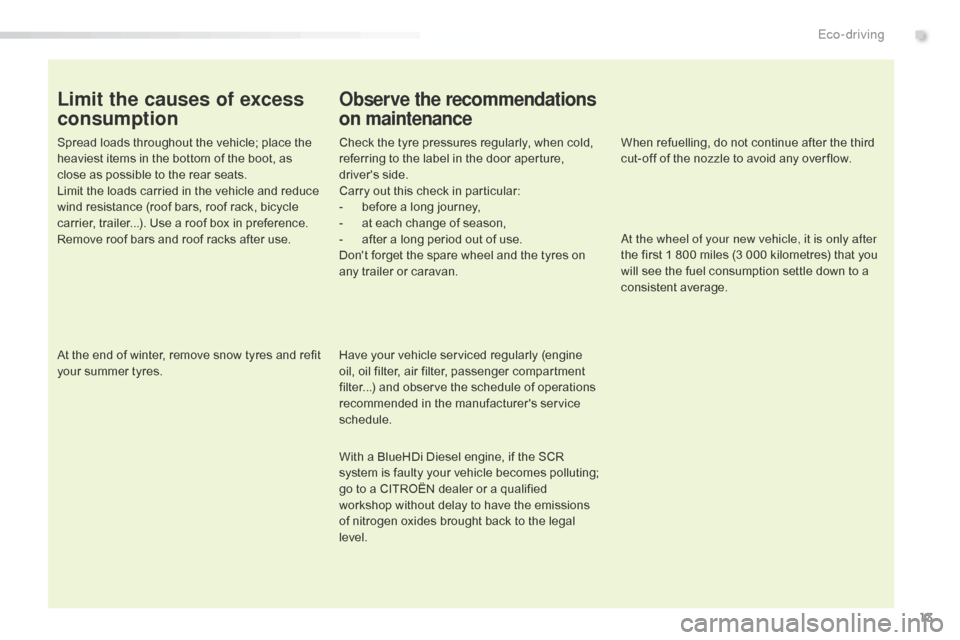
13
Limit the causes of excess
consumption
Spread loads throughout the vehicle; place the
heaviest items in the bottom of the boot, as
close as possible to the rear seats.
Limit the loads carried in the vehicle and reduce
wind resistance (roof bars, roof rack, bicycle
carrier, trailer...). Use a roof box in preference.
Remove roof bars and roof racks after use.
At the end of winter, remove snow tyres and refit
your summer tyres.
Observe the recommendations
on maintenance
Check the tyre pressures regularly, when cold,
referring to the label in the door aperture,
driver's side.
Carry out this check in particular:
-
b
efore a long journey,
-
a
t each change of season,
-
a
fter a long period out of use.
Don't forget the spare wheel and the tyres on
any trailer or caravan.
Have your vehicle serviced regularly (engine
oil, oil filter, air filter, passenger compartment
filter...) and observe the schedule of operations
recommended in the manufacturer's service
schedule.
With a BlueHDi Diesel engine, if the SCR
system is faulty your vehicle becomes polluting;
go to a CITROËN dealer or a qualified
workshop without delay to have the emissions
of nitrogen oxides brought back to the legal
level. When refuelling, do not continue after the third
cut-off of the nozzle to avoid any over flow.
At the wheel of your new vehicle, it is only after
the first 1 800 miles (3 000 kilometres) that you
will see the fuel consumption settle down to a
consistent average.
.
Eco-driving
Page 16 of 520
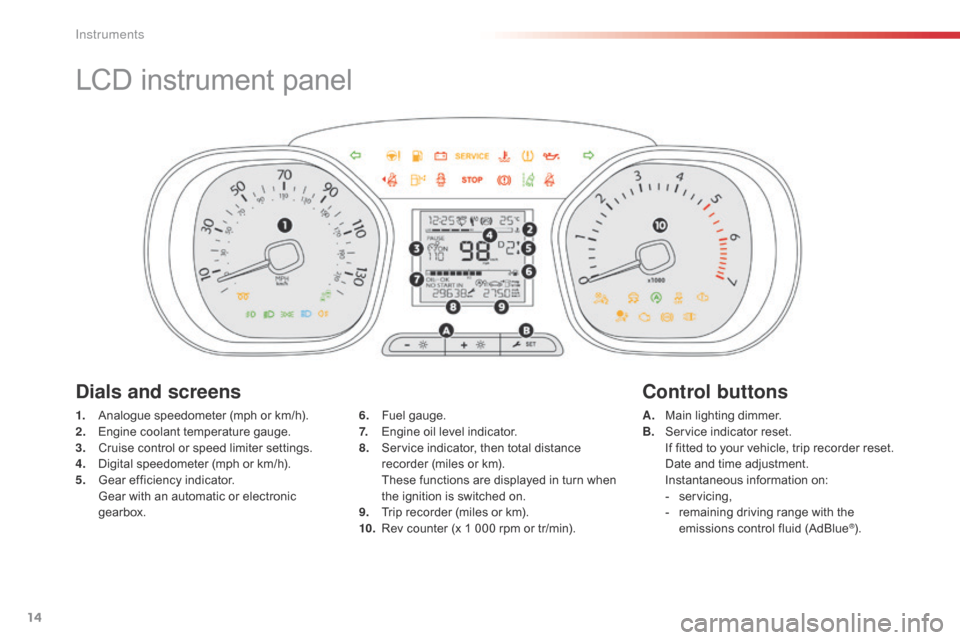
14
LCD instrument panel
1. Analogue speedometer (mph or km/h).
2. Engine coolant temperature gauge.
3.
C
ruise control or speed limiter settings.
4.
D
igital speedometer (mph or km/h).
5.
G
ear efficiency indicator.
G
ear with an automatic or electronic
gearbox. A. M
ain lighting dimmer.
B. S ervice indicator reset.
I
f fitted to your vehicle, trip recorder reset.
D
ate and time adjustment.
I
nstantaneous information on:
-
ser
vicing,
-
r
emaining driving range with the
emissions control fluid (AdBlue
®).
6.
F
uel gauge.
7.
E
ngine oil level indicator.
8.
S
ervice indicator, then total distance
recorder (miles or km).
T
hese functions are displayed in turn when
the ignition is switched on.
9.
T
rip recorder (miles or km).
10. R
ev counter (x 1 000 rpm or tr/min).
Dials and screens
Control buttons
Instruments
Page 17 of 520
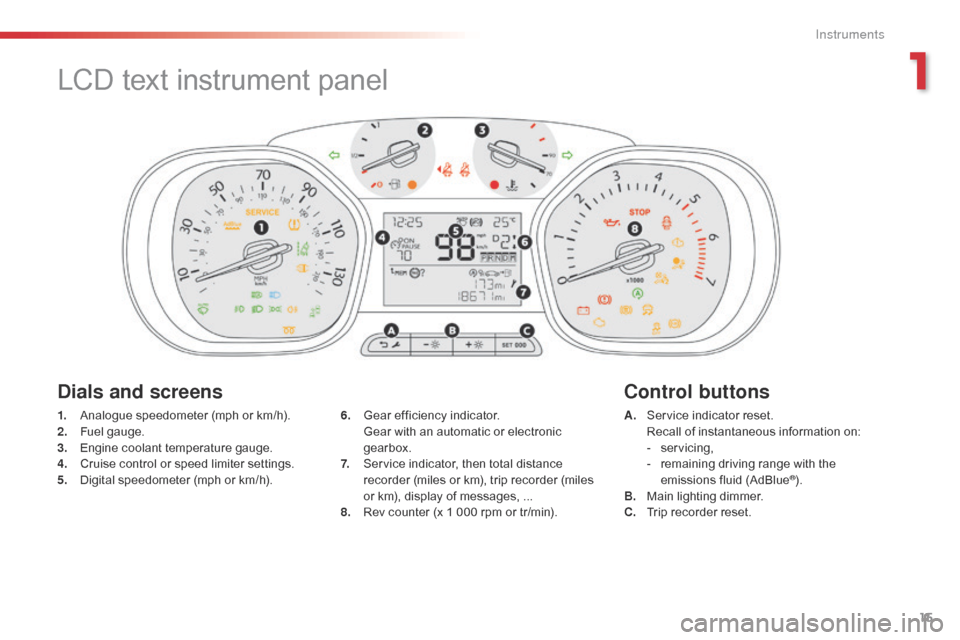
15
1. Analogue speedometer (mph or km/h).
2. Fuel gauge.
3.
E
ngine coolant temperature gauge.
4.
C
ruise control or speed limiter settings.
5.
D
igital speedometer (mph or km/h). A. S
ervice indicator reset. R
ecall of instantaneous information on:
-
ser
vicing,
-
r
emaining driving range with the
emissions fluid (AdBlue
®).
B. M
ain lighting dimmer.
C.
T
rip recorder reset.
6.
G
ear efficiency indicator.
G
ear with an automatic or electronic
gearbox.
7.
S
ervice indicator, then total distance
recorder (miles or km), trip recorder (miles
or km), display of messages, ...
8.
R
ev counter (x 1 000 rpm or tr/min).
Dials and screens Control buttons
LCD text instrument panel
1
Instruments
Page 18 of 520
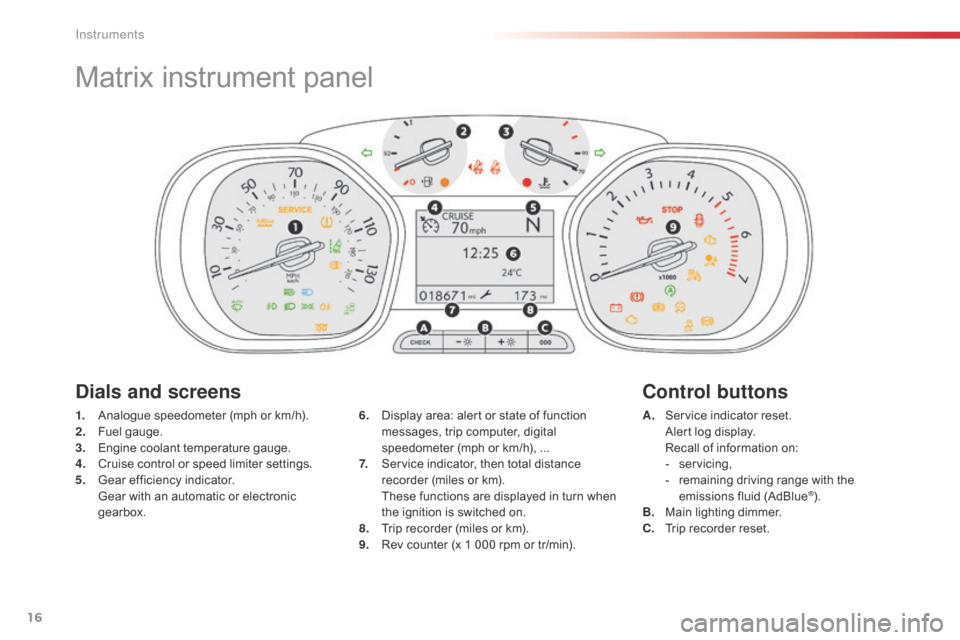
16
Matrix instrument panel
1. Analogue speedometer (mph or km/h).
2. Fuel gauge.
3.
E
ngine coolant temperature gauge.
4.
C
ruise control or speed limiter settings.
5.
G
ear efficiency indicator.
G
ear with an automatic or electronic
gearbox. A. S
ervice indicator reset. A
lert log display.
R
ecall of information on:
-
ser
vicing,
-
r
emaining driving range with the
emissions fluid (AdBlue
®).
B. M
ain lighting dimmer.
C.
T
rip recorder reset.
6.
D
isplay area: alert or state of function
messages, trip computer, digital
speedometer (mph or km/h), ...
7.
S
ervice indicator, then total distance
recorder (miles or km). T
hese functions are displayed in turn when
the ignition is switched on.
8.
T
rip recorder (miles or km).
9.
R
ev counter (x 1 000 rpm or tr/min).
Dials and screens Control buttons
Instruments
Page 19 of 520

17
Indicator and warning
lamps
Visual indicators informing the driver that
a system is in operation or is switched off
(indicator lamp), or has a fault (warning lamp).
When the ignition is switched on
Certain warning lamps come on for a few
seconds when the vehicle's ignition is
switched on.
When the engine is started, these same
warning lamps should go off.
If they remain on, before moving off, refer to the
information on the warning lamp concerned.
Associated warnings
Certain warning lamps may come on in one of
two modes: fixed (continuous) or flashing.
Only by relating the type of illumination to the
operation of the vehicle can it be determined
whether the situation is normal or a fault has
occurred. In the event of a fault, the illumination
of the warning lamp may be accompanied by
an audible signal and/or a message.
Warning lamps
When the engine is running or the vehicle is
being driven, illumination of one of the following
warning lamps indicates a fault which requires
action on the part of the driver.
Any fault resulting in the illumination of a
warning lamp must be investigated further
using the associated message.
If you encounter any problems, contact a
CITROËN dealer or a qualified workshop.
Operation indicator lamps
If one of the following indicator lamps comes on
in the instrument panel and/or instrument panel
screen, this confirms that the corresponding
system has come into operation.
Deactivation indicator lamps
If one of the following indicator lamps comes
on, this confirms that the corresponding system
has been switched off intentionally.
This is may be accompanied by an audible
signal and the display of a message.
1
Instruments
Page 20 of 520

18
Warning / indicator lampStateCause Action / Observations
STOP fixed, associated with
another warning lamp,
accompanied by an
audible signal and a
message. Illumination of this warning lamp is
related to a serious fault detected
with the engine, the braking system,
the power steering, etc., or a major
electrical fault. You must stop as soon as it is safe to do so.
Park, switch off the ignition and call a CITROËN
dealer or a qualified workshop.
Parking brake fixed. The parking brake is applied or not
properly released. Release the parking brake to switch off the warning
lamp, keeping your foot on the brake pedal.
Observe the safety recommendations.
For more information on the Parking brake
, refer to
the corresponding section.
Braking fixed. The brake fluid level has dropped
significantly. You must stop as soon as it is safe to do so.
Top-up with brake fluid listed by CITROËN.
If the problem persists, have the system checked by a
CITROËN dealer or a qualified workshop.
+ fixed, associated
with the ABS warning
lamp.The electronic brake force distribution
(EBFD) system has a fault.
You must stop as soon as it is safe to do so.
Have it checked by a CITROËN dealer or a qualified
workshop.
Instruments